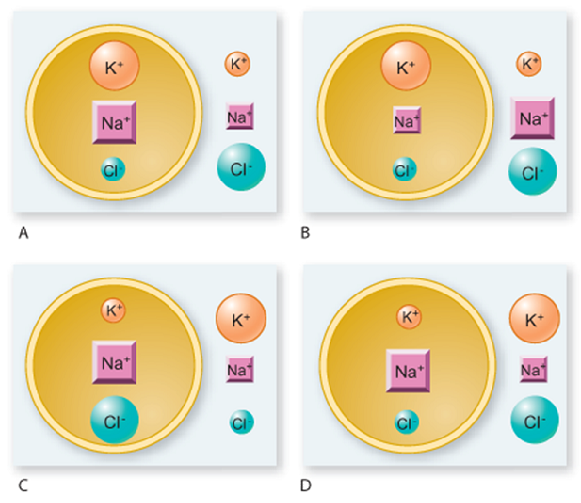Which diagram correctly illustrates the distribution of ions in a resting neuron? (Note: A larger symbol indicates a higher concentration of that ion.)

A. A
B. B
C. C
D. D
Clarify Question
· What is the key concept addressed by the question?
· What type of thinking is required?
Gather Content/Choose Answer
· What do you already know about ions in cells? What other information is related to the question?
Reflect on Process
· Did your problem-solving process lead you to the correct answer? If not, where did the process break down or lead you astray? How can you revise your approach to produce a more desirable result?
B. B
Clarify Question
· What is the key concept addressed by the question?
o The question is asking about the relative distribution of key ions (sodium, potassium, and chloride) across the membrane of a neuron.
· What type of thinking is required?
o This question is an analyze question because you have to understand the differential distribution (shown by the size of the icons) of ions in a neuron during its resting state.
Gather Content/Choose Answer
· What do you already know about ions in cells? What other information is related to the question?
o To solve this problem, you’ll need to apply your knowledge of the differential concentration of ions across all cell membranes, which causes a membrane potential. At rest this potential is referred to as the resting membrane potential, as opposed to an action potential, which is caused by a rapid, but transient, shift away from the resting membrane potential. Resting membrane potential is largely controlled by the distribution of K+ ions, with equilibrium being reached with much greater K+ inside the cell compared to outside the cell. Action potentials are produced by an influx of Na+ ions going down their concentration gradient. Thus, the concentration of Na+ must be greater outside the cell than inside. Remember that this unequal distribution of Na+ and K+ is produced by sodium-potassium pumps that transport 2 potassium ions inside and 3 sodium ions outside of the cell.
Reflect on Process
· Did your problem-solving process lead you to the correct answer? If not, where did the process break down or lead you astray? How can you revise your approach to produce a more desirable result?
o If you figured out the correct answer, great! If not, where in your thought process did things go wrong? If you arrived at an incorrect answer, were you thinking that a neuron at rest should have its ions in equilibrium and did you wrongly assume that electrochemical equilibrium meant that concentrations of ions are the same on both sides of the membrane?
o Answering this question correctly depended upon on distinguishing between the differing distribution patterns of Na+, K+, and Cl- ions while at resting membrane potential.
You might also like to view...
Which of the following is not a way transposons can benefit the host?
A. Some transposons contain antibiotic resistance genes. B. Some transposon sequences (Alu) are used as target sites for RNA editing. C. The antibody diversity mechanism has evolved from ancient cellular invasion by transposons. D. Movement of transposons can disrupt genes that control the cell cycle, giving the host cell a growth advantage over neighboring cells. E. If genes captured by transposons are duplicated, one copy may evolve and acquire new functions.
Passive immunity can be obtained by:
a. having the disease b. receiving a vaccination against the disease c. receiving antibodies by injection d. receiving memory B cells from a donor e. receiving a booster vaccination
As part of observation in your scientific method, you discover that your strawberry plants are producing plantlets that are identical to the parent plant. This demonstrates that they reproduce by
A. development and maturation. B. fragmentation. C. development and adaptation. D. sexual reproduction. E. asexual reproduction.
Which of the following is not true of Ebola and Marburg?
A. They are filoviruses. B. The viruses are transmitted by mosquitoes. C. They transmitted by direct contact with body fluids from affected individuals. D. There is currently no effective treatment for infected individuals. E. Blood clotting is disrupted in an infection with these viruses.